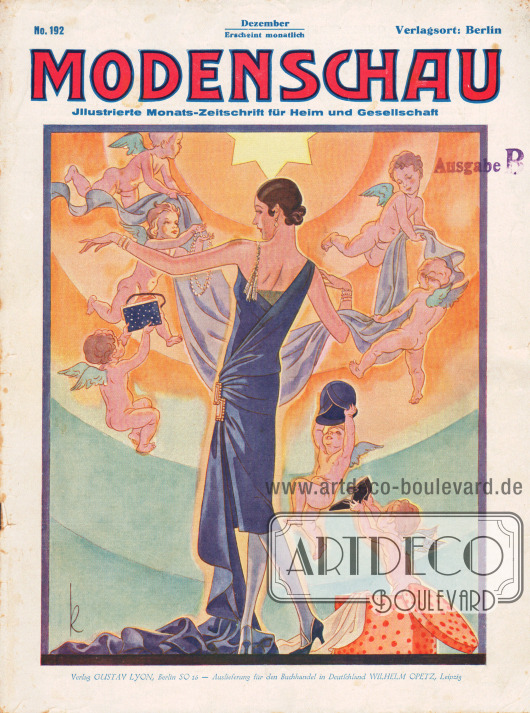|
|
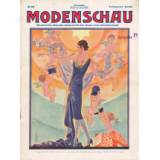
|
Front page or cover of the German fashion magazine Modenschau (Eng. title: Fashion Show, subtitle: Illustrated monthly magazine for home and society) no. 192 for December 1928.
The title drawing shows an elegantly positioned lady with a length of fabric draped and wrapped around her slender body to form an evening gown. Small angels hold a cloth panel or hand the woman suitable accessories.
[Stamp:] Issue B [probably issue for subscribers].
December. Published monthly.
Place of publication: Berlin.
Price per issue: 70 Pfg., with pattern sheet 80 Pfg., plus local delivery charge.
Publishing company Gustav Lyon, Berlin SO 16 – Delivery for the book trade in Germany Wilhelm Opetz, Leipzig.
Title illustration/title drawing: "k", Ernst Ludwig Kretschmann (1897-1941).
|
|
|

|
Article:
N. N., Anecdotes.
Advertising:
MARCEL YOURSELF IN 10 MIN.
Try the easy way of marcelling yourself and you will be surprised by the success. Without gas or electricity! The hair is simply wrapped around the arm of the waver and in 10 to 15 min. you get a wave that the most skilled hairdresser can not make better. You save time and money! The "West Electric Weller" is magnetic, can not burn, break or damage the hair. The simplicity itself, made of the finest nickel steel and indefinitely durable. Try this excellent invention without risk, because if you are not satisfied, we will refund your money. We are convinced that you will never want to miss the "West Electric Weller" once you see how beautifully and easily it works. If not available in stores, we will send you a sample card free of postage (cash on delivery M 1.40) for M 1.15 by postal order or postal check account Berlin 129 211. Please indicate whether for long hair or for bob.
WEST ELECTRIC Hair-Weller for long hair and bob. 1 card with 4 pieces M 1.—.
West Electric Kosmetische Artikel G.m.b.H., Dept. 25, Berlin W 8, Kronenstrasse 60.
With the deep décolleté of the modern toilette, the charm of naturally youthful skin is quite advantageous. Therefore, the consistent use of the genuine Steckenpferd Lilienmilch [Eng. "hobbyhorse lily milk"] soap, which has been tried and tested in the service of feminine beauty, is a vital necessity for sensitive women; after all, it allows skin and face to shine daily in new, unaffected freshness.
Steckenpferd Lilienmilch Soap.
Well-prepared you go to the theater, to society and dance. You appear disruptive and not very tactful when you disturb the peace of a devout auditorium by coughing and similar cold symptoms. You increase the pleasure for yourself if you always take Kaiser's chest caramels as a preventive measure. But if you have a cough, catarrh, sore throat, then the safest and fastest way to help you is only this remedy, which has proven itself for decades. Always look for the brand "3 Tannen" ["3 firs"], in pharmacies, drugstores and where posters visible. Bag 40 Pfg., tin 60 Pfg.
Kaiser's chest caramels with the 3 firs.
GENTILA ABDOMINAL SUPPORTER.
The original American Gentila Empire Abdominal Supporter is superior to all others for the following reasons:
1. It provides a uniform elastic support without constricting or pinching and has no cumbersome stiffeners, buckles, thigh bands, etc.
2. It always adapts to the body in a soft and supple way and always keeps its correct fit.
3. Its air permeability allows excellent ventilation of the skin.
4. By constant, self-acting massage, it strengthens the tissues and muscles and also stimulates the function of the abdominal organs in a beneficial way.
The original American Gentila Empire abdominal supports are unsurpassably proven and often prescribed and examined by doctors for obesity, sagging abdomen, abdominal operations, abdominal and umbilical hernia, low back pain, lowering of the internal organs, wandering kidney, abdominal disorders, before and after childbirth to reduce discomfort and prevent sagging abdomen, as well as for any case where an abdominal support can be useful at all.
Ask for catalog L70 for ladies and Lh70 for men.
J. J. Gentil G.m.b.H., Berlin W 9, Potsdamer Str. 5 (at Potsdamer Platz).
Europe's largest specialty store for abdominal belts, figure enhancers, elastic stockings. Est. 1900. 8 fitting rooms. Open 9 a.m. – 6 p.m. Telephone Luetzow 4610 and 7433.
|
|
P. 1 |

|
Title page or cover of the Modenschau (Eng. title: Fashion Show, subtitle: magazine for home and society) no. 192 for December 1928.
Article:
Wentz, Paulina, Christmas Near and Far (by Paulina Wentz, unknown author).
The article is accompanied by a photographic image with the caption "Nativity art. Middle group of a 17th century Neapolitan round crib, now in the Bavarian National Museum in Munich. Heads modeled in clay, bodies carved in wood, fabric clothing."
Photo: Kester (Philipp Kester, 1873-1958).
[Page] 1
|
|
P. 2 |

|
Article:
Lagerloef, Selma, Our Lord and St. Peter (by Selma Ottilia Lovisa Lagerloef, Swedish writer, 1858-1940, excerpt from the book: Christuslegenden [Legends of Christ], Publisher Albert Langen, Munich).
The illustration above, without caption, shows Jesus Christ and St. Peter standing on a mountainside. Jesus reaches out his hand to a bird that is about to perch on his hand. St. Peter is amazed and holds a hand in front of his face.
Illustration/drawing: "k", Ernst Ludwig Kretschmann (1897-1941).
[Page] 2
|
|
P. 3 |
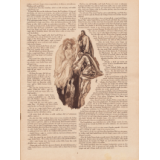
|
Article:
Lagerloef, Selma, Our Lord and St. Peter (by Selma Ottilia Lovisa Lagerloef, Swedish writer, 1858-1940, excerpt from the book: Christuslegenden [Legends of Christ], Publisher Albert Langen, Munich).
The illustration in the center without caption shows St. Peter and Jesus Christ at a precipice. Peter is holding out his arms to a man who is falling. A hovering angel watches over the scene.
Illustration/drawing: "k", Ernst Ludwig Kretschmann (1897-1941).
[Page] 3
|
|
P. 4 |
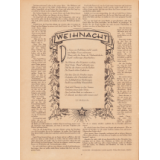
|
Article:
Lagerloef, Selma, Our Lord and St. Peter (by Selma Ottilia Lovisa Lagerloef, Swedish writer, 1858-1940, excerpt from the book: Christuslegenden [Legends of Christ], Publisher Albert Langen, Munich);
Emil Ferdinand Malkowsky, Christmas (poem by Emil Ferdinand Malkowsky, 1880-1967).
[Page] 4
|
|
P. 5 |
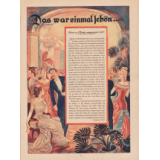
|
Article (gloss):
Elias, Julie, That Was Once Beautiful… Gloss on Fashions of a Bygone Era (by Julie Elias, born as Julie Levi, 1866-1945).
That was once beautiful… gloss on fashions of a bygone era — by Julie Elias —
From clothes, too, if one knows nothing else about it, one can read the spirit of an epoch, its morals and aesthetics, its political and social attitudes; one senses the tranquility or restlessness, the well-being or the distress of a people. From fashion follies, these sins against good taste and aesthetic feeling, one can conclude that storms rage through the human breast. Then again, fashion reveals the ideal that a time has made for itself of women's beauty. The basis of this ideal was always different, the naked woman was thought of, the clothed woman was thought of: usually the beauty was judged only by the dress, and the figure of the woman disappeared under it, one need only remember the crinoline or the wasp waist or the time when a full bosom was considered beautiful, and the corsets were puffed up with cotton batting or tires so that they feigned fullness of bosom. In the days that followed the French Revolution, people again raved about simplicity and naturalness, and under the Greco-Roman robe no part of the female body remained hidden, classical beauty is naked or only slightly covered, people wanted to see the body, to enjoy it, its line, its rhythm.
To our time, when the ideal of the practical and the beautiful coincides in clothing, when sport, hygiene, massage and not least the desire of women work to make their appearance slender, boyish, unconstrained, the fashions of the nineties of the last century must seem ridiculously artificial and exaggerated. How impossible do… (continued on page 8).
Illustration/Drawing: "k", Ernst Ludwig Kretschmann (1897-1941).
[Page] 5
|
|
P. 6 |
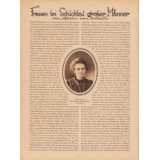
|
Article:
Erbach, Alvin von, Women in the Fate of Great Men (by Alwin von Erbach, unknown author).
The photograph in the center of the article shows "Mrs. [Marie Skłodowska] Curie [1867-1934], the famous co-discoverer of radium."
Photo: circa 1898, unknown.
[Page] 6
|
|
P. 7 |
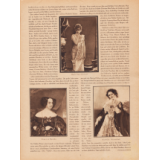
|
Article:
Erbach, Alvin von, Women in the Fate of Great Men (by Alwin von Erbach, unknown author).
The three photographic images show "Marie Baschkirtseff [sic! Marie Bashkirtseff, Ukrainian painter, 1858 or 1860-1884]" and the paintings of "Lady von Hanska [Ewelina Hańska, Polish noblewoman, 1801-1882]" and "Mathilde Wesendonk [Agnes Mathilde Wesendonck, born Agnes Luckemeyer, German writer, 1828-1902]."
Photos: unknown/unsigned.
Paintings: left: unknown; right: Karl Ferdinand Sohn (1805-1867).
[Page] 7
|
|
P. 8 |
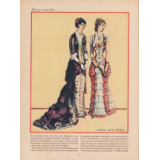
|
Article (gloss):
Elias, Julie, That Was Once Beautiful… Gloss on Fashions of a Bygone Era (by Julie Elias, born as Julie Levi, 1866-1945).
That was once beautiful… [Illustration shows fashion of the years] 1880 — 1882.
[Continued from page 5] … these corset figures, these bustles, these ham sleeves, these train skirts and overloaded giant hats seem to us today! Truly, from the sublime to the ridiculous is only a step – even in fashion. How right an old French saying is that the ridiculous has a sharper, more cutting effect than the iron of the guillotine.
It is easy to criticize these fashions, to reduce their folly and ugliness to absurdity, but it is more difficult to understand them, to fathom their former magic. One must remember the social position of the woman of that time, her completely different mental attitude, just at the inner format of these dresses this becomes so rightly apparent to us. The woman was inwardly constricted and bound, and this was also expressed in the fashion, even the clothes bound and constricted. Fashion was dominated by the imagination, therefore the changes within fashion were greater, their change more frequent. [continued on page 9]
[Page] 8
|



